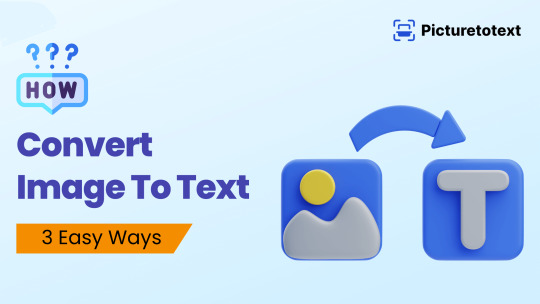#Editabletext
Text

Do you have a photo with words you wish you could just copy and paste? 📸✍️ We've got the trick! In our latest blog, We'll show you how to Convert Images to Editable Text with 3 Easy Ways. So, no more typing it all out! Check it out and make life easier! 😄👍
https://picturetotext.info/blog/how-to-convert-image-to-text
#technews#Editabletext#optical character recognition#productivitytips#productivityboost#blog post#techhacks#convertimagetotext#Imagetotext
0 notes
Text
How to use Junit and Espresso for Unit testing in Android TV app
Unit testing is the most important form of testing, one should follow while developing the Android TV application. The unit test is generally written before writing the code for the actual application. Junit is a very popular unit testing framework used by Android TV Developer for projects that have the XML and the java files with android dependencies. Junit and Espresso help the Android TV App Developer in performing unit testing.

The Espresso is a popular instrumentation Testing framework provided by Google for user interface testing of the Android TV applications. It is used by Android TV developer to write concise, precise and reliable Android UI tests. The Espresso test runs very fast and is advantageous. This API is small and too easy to learn. The below is an example snippet of Espresso Unit test for Android TV application
@Test
public void greeterSaysHello() {
onView(withId(R.id.name_field)).perform(typeText("Steve"));
onView(withId(R.id.greet_button)).perform(click());
onView(withText("Hello Steve!")).check(matches(isDisplayed()));
}
In the above snippet, one important point to note is that every time the test invoked the onView() method, this Espresso completely waits to finish the specific UI action till the message queue gets empty or the resources becoming idle. Android TV developer test the different interactions, the state expectations and the assertions in a very precise manner using the Espresso. The common 6 types of Espresso Annotations include @Test, @Before, @BeforeClass, @After, @AfterClass, @Rule. The below pic is a depiction of the espresso test of the view

The main activity of the developed Android TV application gets launched using the @Rule. The rule is then initialized, while the activity gets launched (onCreate, onStart, onResume) before the running of the @Before method. The UI component must be specified, the view matcher should also be specified by calling the methods in class.
Junit Testing
The Junit widely serves as the automation framework for the unit as well as the user interface testing. Many annotations are present such as @Test, @Before, and @After. Let’s consider the below Java Class for performing the function of validating the email by the Android TV developer
import android.text.Editable;
import android.text.TextWatcher;
import java.util.regex.Pattern;
/**
* An Email format validator for
*/
public class EmailValidator implements TextWatcher {
// Email validation pattern.
public static final Pattern EMAIL_PATTERN = Pattern.compile(
"[a-zA-Z0-9\\+\\.\\_\\%\\-\\+]{1,256}" +
"\\@" +
"[a-zA-Z0-9][a-zA-Z0-9\\-]{0,64}" +
"(" +@Test
"\\." +
"[a-zA-Z0-9][a-zA-Z0-9\\-]{0,25}" +
")+"
);
private boolean mIsValid = false;
public boolean isValid() {
return mIsValid;
}
/* Validates if the given input is a valid email address, @param email (The email to validate)
* @return {@code true} if the input is a valid email. {@code false} otherwise.*/
public static boolean isValidEmail(CharSequence email) {
return email != null && EMAIL_PATTERN.matcher(email).matches();
}
@Override
final public void aftertheTextChanged(Editable editableText) {
mIsValid = isValidEmail(editableText);
}
@Override
final public void beforetheTextChanged(CharSequence s, int start, int count, int after) {/*No-op*/}
@Override
final public void ontheTextChanged(CharSequence s, int start, int before, int count) {/*No-op*/}
}
The above is the example for the EmailValidator class. Android TV developer uses JUnit testing framework to write unit test cases for the class. The below code is considered as the EmailValidatorTest.java
Correct Input: @Test annotation is offered by the JUnit Framework for unit testing for the android tv app development. In Android tv development, every method is taken as a test case for performing the unit tests for different test cases.
@Test
public void emailValidator_CorrectEmailSimple_ReturnsTrue() {
assertTrue(EmailValidator.isValidEmail("[email protected]"));
}
Email with the right subdomain: The assertTrue() method of the Junit framework is used by Android Tv developer to force value present within the brackets to be true in the android tv development.
@Test
public void emailValidator_CorrectEmailSubDomain_ReturnsTrue() {
assertTrue(EmailValidator.isValidEmail("[email protected]"));
}
Without .com in the email address: Here the method assertFalse() is implemented by the Android tv developer to force the arguments value to be false
@Test
public void emailValidator_InvalidEmailNoTld_ReturnsFalse() {
assertFalse(EmailValidator.isValidEmail("name@email"));
}
Being a proficient smart TV app development company across the countries like the USA, U, and Australia, at 4 Way Technologies we also focus on the unit testing in the Android TV development using Junit and Espresso. This framework helps the Android TV Applications in performing the unit test for the Android TV application. With the help of these automated frameworks, unit testing can be done precisely and rapidly by the Android TV developer during the Android TV app development without any difficulty.
#Android TV Developer#Android TV App Development#Android TV Development#Android TV#Technology#Smart TV
0 notes